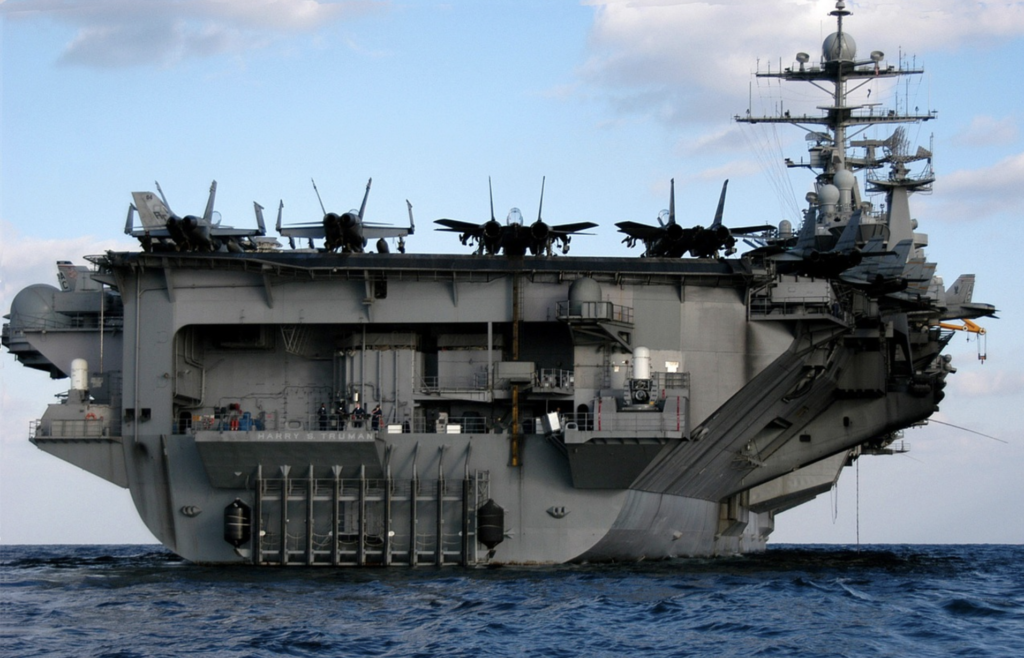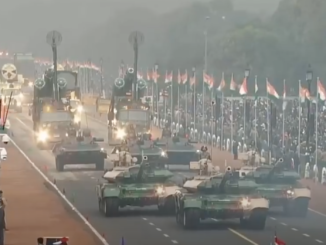
The importance of naval power projection can be encapsulated in the words of Erich Raeder, “All wars will be settled by sea power.” Samuel Eliot Morison has argued, “no big modern war has been won without preponderant sea power; and, conversely, very few rebellions of maritime provinces have succeeded without acquiring sea power.” For Alfred Mahan, “sea is a great path open to all,” and “control of the sea is and has been a great factor in the history of the world.” The British Navy ruled the seas in early phase of modern naval history due to its superior flotilla of battleships. However, the end of WWII marked the end of battleships due to emergence of a new category of war ships which were far more flexible to employ and were much more efficient in terms of combat utility. These warships were aircraft carriers which introduced the concept of aerial power projection via sea for the first time in human history.
The initiation of Cold War also marked the beginning of US aircraft carrier domination. Taking advantage of its vast military industry, experience of naval combat in Pacific, and dual oceanic connectivity, United States Navy (USN) emerged as the most capable naval force in the world. USN Carrier Strike Groups (CSGs) were deployed at key strategic points to establish control of Sea Lines of Communications (SLOCs) and for the implementation of sea borne coercive strategies. Even Soviet Union, which was competing with USA with parity on all grounds, struggled to match the USN due to it’s technological, political and geographical limitations. So, instead of formulating an analogous response, the Russian Navy fielded battlecruisers and bombers equipped with anti-ship cruise missiles (ASCMs) to counter American CSGs. The carrier-based assertive posture of Washington reshaped the concept of gun boat diplomacy – a concept which involves the forward deployments of military assets (primarily carrier groups) to coerce the adversaries for achieving requisite political and diplomatic objectives. The USA continues to exercise this policy successfully to present day.
In military terminology, a weapon system is termed obsolete if the risks and costs of operating that system out-weigh the benefits and capabilities that system provides to its user. When discussing aircraft carriers from this perspective, we have to take into account (i) the capabilities of carrier borne aviation assets and (ii) the survivability of the aircraft carriers in the dense threat environment they are meant to operate. These two parameters primarily depend on the adversary’s combat potential, particularly Anti-Access Area Denial (A2/AD) prowess, which from the standpoint of threat environment acuteness, vary from place to place and time to time. This article will briefly evaluate the contemporary and near future kinetic threats to CBGs and defensive countermeasures available or yet to be available against such threats. For sake of simplicity, the examples of USN carriers will be taken into account with respect to the emerging combat landscape of Pacific region.
The Case of Carrier Based Combat Aviation. The carrier based naval aviation group – comprising of fighter aircrafts, air borne early warning and control systems (AEWCS), anti-submarine warfare and search and rescue helicopters – is facing a similar existential challenge as air forces around the globe. The proliferation of multi-layer air defense systems, advance search and track systems, and increasing air combat potency of hostile fighter aircrafts have narrowed down the window of operability of carrier-based aviation wings. USN has taken six major measures to sustain its operational advantage: first, the fielding of stealth aircrafts, i.e. F-35B/C, which have extremely low radar cross section, hence are very difficult to detect and can serve as primary combat asset; second, the employment of new EW aircrafts, i.e. E/A-18G, which can jam the enemy’s electronic capabilities; third, the fielding of unmanned systems including aerial tankers, i.e. MQ-25 Stingray, which can refuel aircrafts in a dense threat environment; fourth, the operationalization of new stand-off munitions which can eliminate the target from long ranges; fifth, the numeric and qualitative increment in anti-submarine warfare assets to thwart undersea threats; and finally the proliferation of manned and unmanned Intelligence-Surveillance-Reconnaissance (ISR) assets for comprehensive situation awareness. This evolution of carrier’s aviation assets, adhered within a network-centric environment, is likely to neutralize the growing A2/AD proficiency of adversaries, thus ensuring the sustainability of efficient power projection of the CSGs.
The Case of Aircraft Carriers Survivability. Aircraft carriers are large naval vessels, in terms of size and displacement, which travel in conjunction with other naval assets including cruisers, destroyers, submarines and replenishment ships to form Carrier Strike Group. While carriers serve as a primary offensive asset, other assets provide defensive cover for thwarting aerial, surface and submerged threats. These threats, however, are rapidly evolving and are the primary reason why experts have started to question the survivability of CSGs against adversaries armed with modern weapons. Briefly, four such threats which can be identified are the following: first, the range, speed and precision of anti-ship cruise missiles (ASCMs) have increased making sea skimming ASCMs hard to detect and intercept; second, the introduction of anti-ship ballistic missiles (ASBMs) – like China’s ground launched and air launched DF-21D ASBMs and anti-ship version of Russian Kh-47M2 ALBM, which have potential of striking carrier size object at ranges over 2,000+ kms; third, the advancement in submarine propulsion systems have made modern subs more silent and consequently even harder to detect; and finally, the progression in surveillance and recon capabilities has made possible the detection and tracking of large surface vessels in Oceanic waters alongside modern sensor suites which can guide long range weapons to the assigned targets. All these assets can constitute multi-layer A2/AD coverage which can deter carrier-based operations by putting the survivability of CSGs at grave risk.
The technological progression, however, has also augmented the defensive capabilities of modern CSGs. The CSGs now carry variety of surveillance assets which can monitor over the horizon threats and can proactively alert the CSGs for pre-emptive measures. The problem with long range missile systems is their dependency on surveillance assets to provide guidance and course corrections information via data link. The proficient options in this regard are either Maritime Patrol Aircrafts (MPAs), Drones, AEWCs or fighter jets equipped with recon pods. But on downside, these aviation assets have to fly in relative proximity of CBGs and therefore they can be intercepted by carrier’s own fighter aircrafts. Even if missiles successfully reach close to target, the multi-layer air defence systems carried by escorting surface vessels and carrier itself can neutralize such threats. Plus, the element of Electronic Warfare (EW), Electronic Countermeasures (ECMs) should also be put into perspective as the approaching missiles can be rendered useless either by blocking the data link or by confusing its sensors using chaffs, flares and decoys.
The contention between technological progression of offensive and defensive capabilities will remain the core factor to shape the future landscape of naval warfare. CBGs possess flexible operability as depending upon the requirement, the escorting fleet can be tailored to better posture for assigned missions. For example, for operating against Iran in narrow waterlines of Persian Gulf, the CBGs can be composed of vessels which are more suitable for thwarting predominately asymmetric threats like swarming of missile boats, sea mines and saturation strikes from Iranian coasts. In contrast, for patrolling in Sino-Pacific theatre, the CBGs can be enlarged to include more cruisers, destroyers and nuclear submarines for increasing the prospects of defence against more complex and diverse challenges while at the same time keeping multiple offensive options, i.e. carrier aviation wing and cruise missiles of accompanying cruisers and destroyers, in their disposal. Alongside, US Officials are working on conversion of Amphibious Assault Ships (LHDs) into light aircraft carriers by upgrading them to support F-35B fleet, for supplementing the role of primary CSGs. The dispersion of carrier borne assets highlights the operational adaptability of CSGs with respect to variability of the threat environment and is the key attribute which will strengthen the probabilities of domination continuation of carrier borne forces in near future. It is worth noting that USN’s primary challenger, i.e. People’s Liberation Army Navy (PLAN), is also building up carrier force which is indication of China’s admiration of capabilities which CSGs provide and no other systems can.
The balance of power is unlikely to undergo major variation even if future generation systems like hypersonic missiles fully operationalize in naval warfare. A similar progression in high energy lasers, sea borne hypersonic cruise missiles and even ship mounted rail guns will keep the balance in favour of technologically advance and economically richer power. Considering the factors like the ability of CSGs to absorb more technologies, the flexible operability, the political will to evolve these vessels further and the absence of alternatives, it it safe to conclude that CBGs will continue to evolve and will retain their current position within naval warfare even in far future.
![]()




Be the first to comment